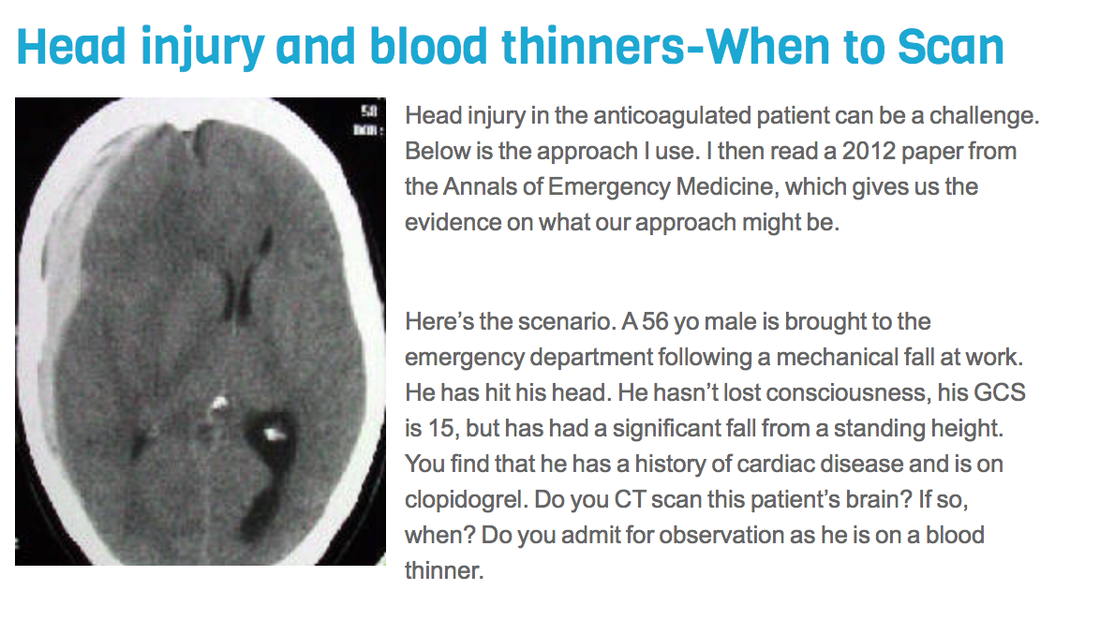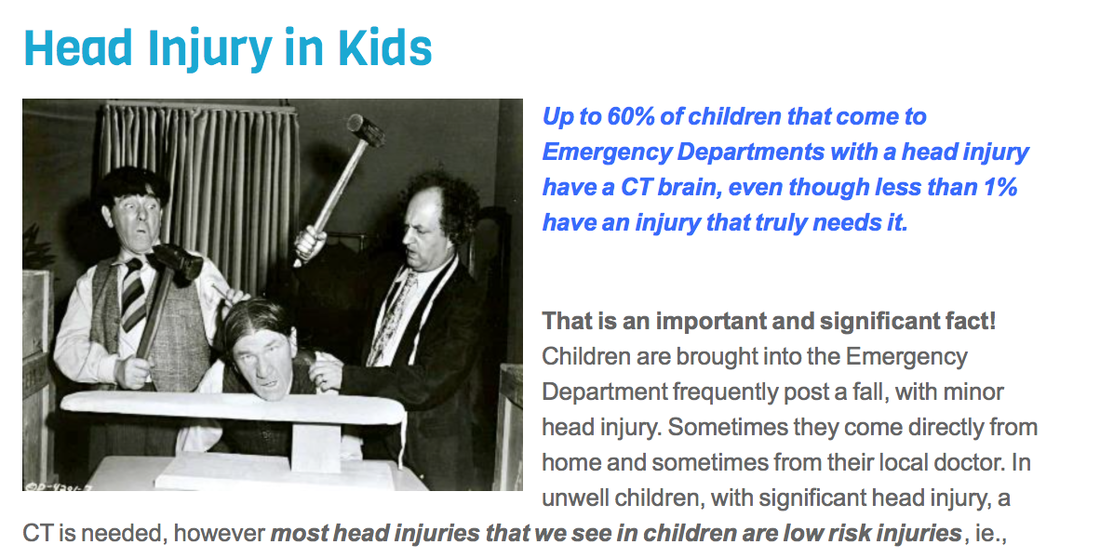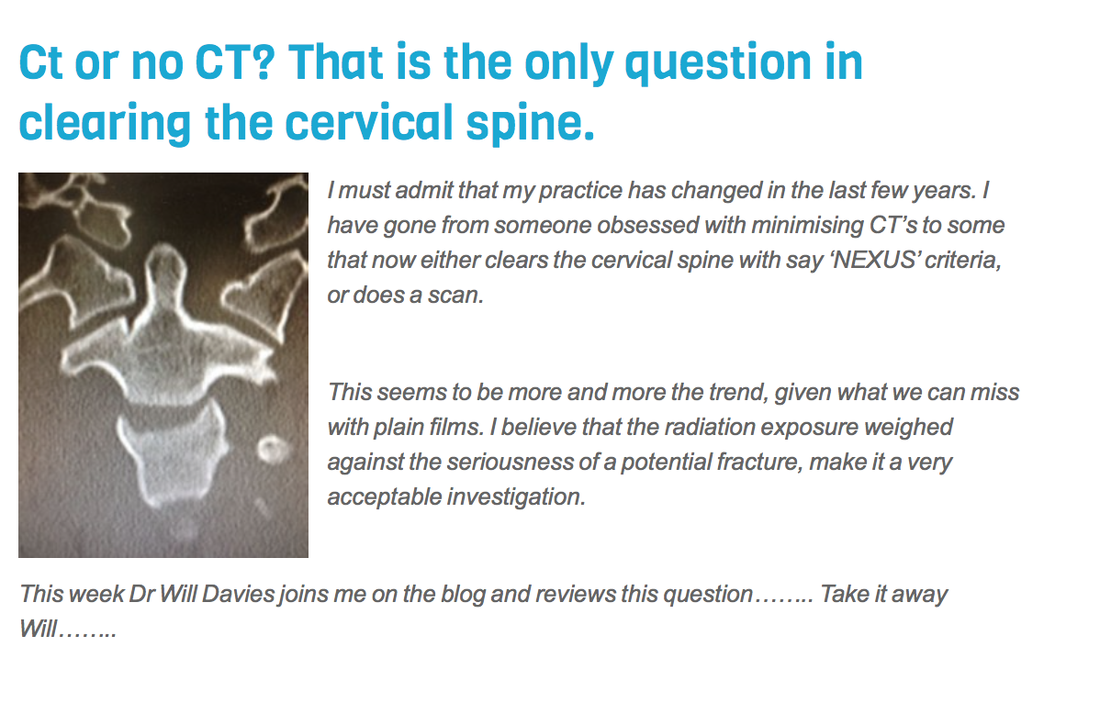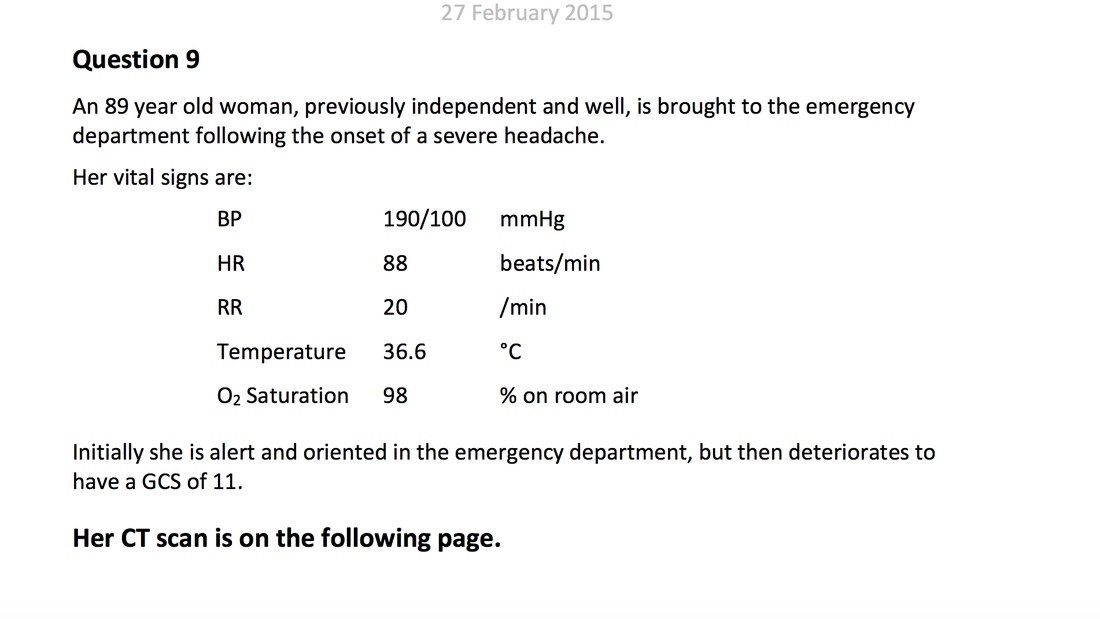MODULE 9: head injuries, c spine injuries and facial/dental trauma.
[the trauma block]
watch.
|
|
|
READ
Below are three blogs discussing much the same issues as the videos.
There is a review of the evidence for CT brains in anti coagulated patients based on the2012 Annals article and a review of paediatric head injuries. To be honest, we think the debate between plain radiography and computed tomography for evaluating the c-spine was settled years ago. On the resus.com.au blog Professor Will Davies wrote a great plain language summary of a technical article in medical physics in 2009 which integrates radiation risk and predictive value for each modality. Check it out below so that you can sound like a guru.
There is a review of the evidence for CT brains in anti coagulated patients based on the2012 Annals article and a review of paediatric head injuries. To be honest, we think the debate between plain radiography and computed tomography for evaluating the c-spine was settled years ago. On the resus.com.au blog Professor Will Davies wrote a great plain language summary of a technical article in medical physics in 2009 which integrates radiation risk and predictive value for each modality. Check it out below so that you can sound like a guru.
If you're after some literature on the relevant paediatric decision rules the paper below is a good review. It's probably only necessary to read the abstract though.
| chalice_pecarn_catch.pdf |
When it comes to dental trauma, it can be hard to find a practical guide. The APLS website posts slides (below) from a Western Sydney dentist named Dr Tony Skapetis, which are an excellent summary of practical dental trauma. The RCH website also has a reasonable practical guideline.
| dental_injuries_-_tony_skapetis.pdf |
solve.
You'll remember from our first face to face meeting is that one of the things we are big on is CONTEXT. (We've even put is here in capital letters so that you can see how important we think it is!).
Every question has clinical information given for good reason. A large part of passing the exam is learning to hear what the examiners are trying to tell you.
This week's solve is not strictly a trauma question, but it is based around a CT brain, and we've put it up to illustrate our point about understanding the examiner's language. To whit, have a look at the question below. It's a real one, from the 2015.1 exam.
Every question has clinical information given for good reason. A large part of passing the exam is learning to hear what the examiners are trying to tell you.
This week's solve is not strictly a trauma question, but it is based around a CT brain, and we've put it up to illustrate our point about understanding the examiner's language. To whit, have a look at the question below. It's a real one, from the 2015.1 exam.
Her CT scan is indeed on the following page. But we are not going to show it to you.
Remember:
1. Every SAQ is fundamentally about one problem.
2. The examiners have already told you the diagnosis.
Think very carefully about the diagnosis, and then see if you can answer the real questions below.
Question 1. (2 marks)
What is the radiological diagnosis and the likely cause?
Question 2. (8 marks)
Give 4 radiologic features that are used to indicate severity in this condition, stating whether they are present or absent.
(Note, I'm aware you can't see the CT and therefore you can't tell absence or presence. I do expect the four features though.)
Question 3. (4 marks)
Give 4 poor prognostic indicators in this woman.
Remember:
1. Every SAQ is fundamentally about one problem.
2. The examiners have already told you the diagnosis.
Think very carefully about the diagnosis, and then see if you can answer the real questions below.
Question 1. (2 marks)
What is the radiological diagnosis and the likely cause?
Question 2. (8 marks)
Give 4 radiologic features that are used to indicate severity in this condition, stating whether they are present or absent.
(Note, I'm aware you can't see the CT and therefore you can't tell absence or presence. I do expect the four features though.)
Question 3. (4 marks)
Give 4 poor prognostic indicators in this woman.
write.
Homework this week is as usual.
1. 3 MCQs on the above trauma subjects.
2. 2 SAQs on the above subjects.
When you are writing your SAQs try to keep a couple of things in mind.
1. The SAQ should be fundamentally centred on one clinical problem
2. Props, particularly photos (e.g. from LITFL or other websites which can be linked by URL to your SAQ) are very popular in trauma SAQs
3. You need to write questions that flow naturally on from each other with giving away the previous or subsequent answers.
Good luck!
1. 3 MCQs on the above trauma subjects.
2. 2 SAQs on the above subjects.
When you are writing your SAQs try to keep a couple of things in mind.
1. The SAQ should be fundamentally centred on one clinical problem
2. Props, particularly photos (e.g. from LITFL or other websites which can be linked by URL to your SAQ) are very popular in trauma SAQs
3. You need to write questions that flow naturally on from each other with giving away the previous or subsequent answers.
Good luck!



